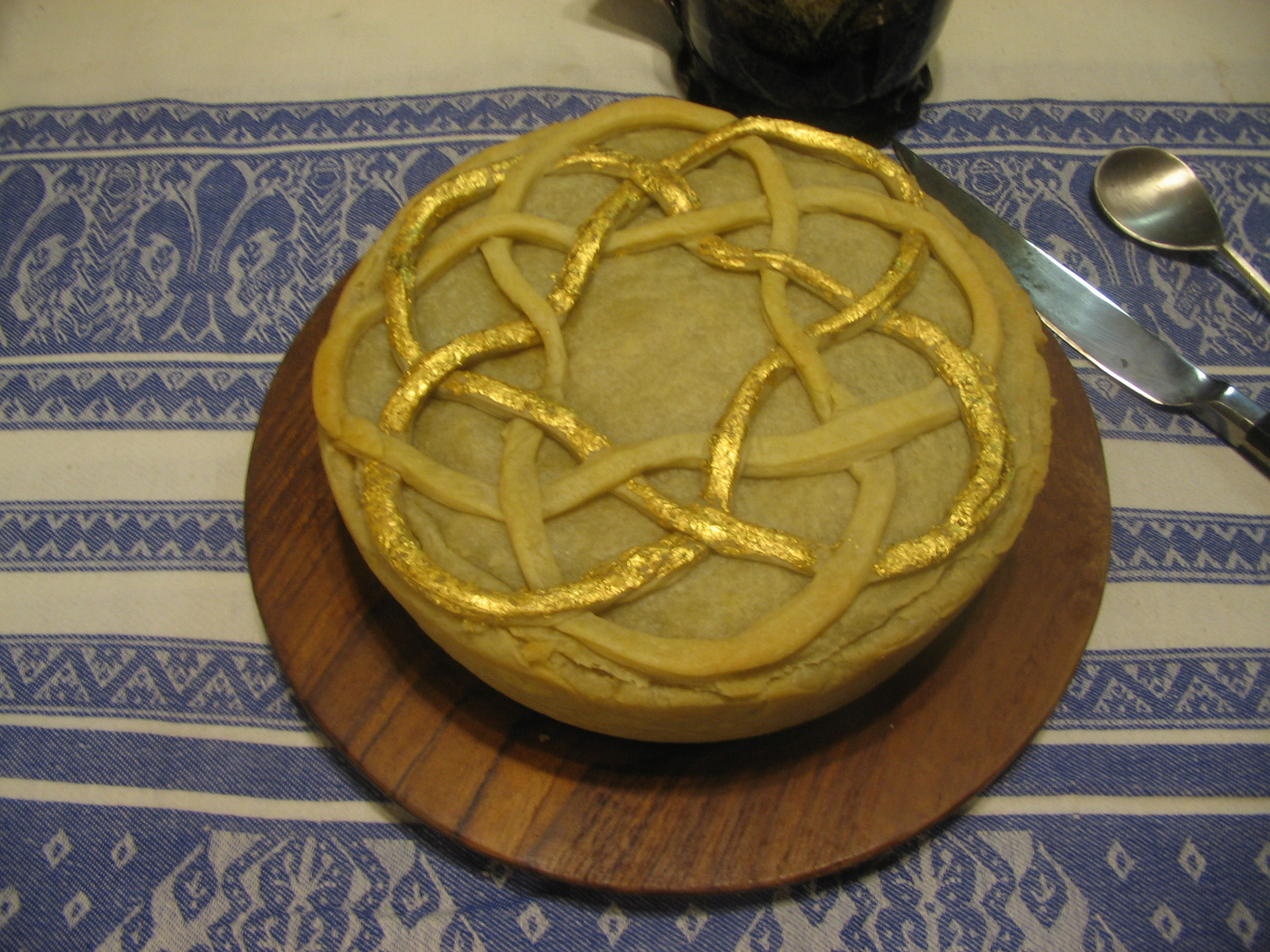Introduction:
The placement of this dish – with what is otherwise a fairly sweet course – was deliberate, as a “we’re not in Kansas anymore, Toto” reminder that Scappi’s menus were using a very different approach to their arrangement than what we might expect, despite the familiarity of many dishes (the salad, the “risotto”, the “porchetta”, the cheesecake, etc).
Unfortunately, neither budget nor labor availability extended to fresh whole artichokes. I was, however, able to find both canned and frozen artichokes, which made this dish still work. Frozen artichoke hearts are a little harder to find, but once thawed and dressed are quite tasty when eaten raw in a salad. They can also be roasted, but are a bit more expensive so it made sense to use the canned ones for the cooked dish.
There’s no formal recipe for this: the canned artichokes were roasted until crispy around the edges with olive oil, salt, and pepper, then dressed with balsamic vinegar and additional pepper; the “fresh” thawed artichokes were dressed with olive oil and lemon juice and garnished with sliced olives and shaved parmesan cheese. (The cheese and olives were mentioned in several menus as appropriate for this course; they were more likely served separately but eating them together was more tasty.)
Scappi – April 8 supper menu – also found in the dinner menu from April 25
Cooked artichokes served with vinegar and pepper
Raw artichokes served with salt and pepper
Parmesan cheese in little slices.
Castlevetro – Of the Artichoke
Follows the artichoke, as we call it in Italy, however it does not last all year, like it does in this fertile land. One eats the artichoke raw and cooked, but there are several rules to follow, because, when they as large as a hazelnut they are good to eat raw, with nothing more than salt, pepper and old cheese. They are good for many to eat without cheese, there are many who abhor this food, the others it generates phlegm, and for others ignorance (why many don’t eat it? Not sure on the language here). They do not know that the flavor comes from them, if they are not larger than a common apple they are good raw. When they are bigger then we cook them however not in that base manner of the English, because the little ones that one doesn’t want to eat raw one cuts away enough of the sprouts of their spiky leaves, and give them first a boil in clear water, which one throws away to reduce the bitterness, and then we finish cooking them in good broth of fat beef or capon, and when they are cooked we put them in a deep plate with some of that broth and above we sprinkle aged cheese grated and pepper and this increases their goodness. And these we have found to be delicious dish for even as I write about it my mouth is watering. In a similar way we make pastries with shucked oysters and beef marrow, not depriving the dish on top salt or pepper, and to make this pastry it is first better to give the heads a boil. The biggest we cook on the grill, cut through the middle of the leaves, and above we add oil, pepper and salt, and after we add sour orange juice to make sure that they keep the green leaves, and we love either way these are cooked to eat. The excessively large, like those which grow on this island, we cook first in water, and then between their large leaves, that are cut in half, we put oysters with their water and bits of beef marrow with pepper, salt and oil or fresh butter, and then we make pastries that are beyond your wildest dreams.
1302597
{1302597:JPRG7UEQ},{1302597:CTQP5R9M}
1
modern-language-association
50
default
1483
https://www.erminespot.com/wp-content/plugins/zotpress/
%7B%22status%22%3A%22success%22%2C%22updateneeded%22%3Afalse%2C%22instance%22%3Afalse%2C%22meta%22%3A%7B%22request_last%22%3A0%2C%22request_next%22%3A0%2C%22used_cache%22%3Atrue%7D%2C%22data%22%3A%5B%7B%22key%22%3A%22CTQP5R9M%22%2C%22library%22%3A%7B%22id%22%3A1302597%7D%2C%22meta%22%3A%7B%22creatorSummary%22%3A%22Scappi%22%2C%22parsedDate%22%3A%222008%22%2C%22numChildren%22%3A2%7D%2C%22bib%22%3A%22%26lt%3Bdiv%20class%3D%26quot%3Bcsl-bib-body%26quot%3B%20style%3D%26quot%3Bline-height%3A%202%3B%20padding-left%3A%201em%3B%20text-indent%3A-1em%3B%26quot%3B%26gt%3B%5Cn%20%20%26lt%3Bdiv%20class%3D%26quot%3Bcsl-entry%26quot%3B%26gt%3BScappi%2C%20Bartolomeo.%20%26lt%3Bi%26gt%3BThe%20Opera%20of%20Bartolomeo%20Scappi%20%281570%29%26lt%3B%5C%2Fi%26gt%3B.%20University%20of%20Toronto%20Press%2C%202008.%26lt%3B%5C%2Fdiv%26gt%3B%5Cn%26lt%3B%5C%2Fdiv%26gt%3B%22%2C%22data%22%3A%7B%22itemType%22%3A%22book%22%2C%22title%22%3A%22The%20Opera%20of%20Bartolomeo%20Scappi%20%281570%29%22%2C%22creators%22%3A%5B%7B%22creatorType%22%3A%22author%22%2C%22firstName%22%3A%22Bartolomeo%22%2C%22lastName%22%3A%22Scappi%22%7D%5D%2C%22abstractNote%22%3A%22Bartolomeo%20Scappi%20%28c.%201500-1577%29%20was%20arguably%20the%20most%20famous%20chef%20of%20the%20Italian%20Renaissance.%20He%20oversaw%20the%20preparation%20of%20meals%20for%20several%20Cardinals%20and%20was%20such%20a%20master%20of%20his%20profession%20that%20he%20became%20the%20personal%20cook%20for%20two%20Popes.%20At%20the%20culmination%20of%20his%20prolific%20career%20he%20compiled%20the%20largest%20cookery%20treatise%20of%20the%20period%20to%20instruct%20an%20apprentice%20on%20the%20full%20craft%20of%20fine%20cuisine%2C%20its%20methods%2C%20ingredients%2C%20and%20recipes.%20Accompanying%20his%20book%20was%20a%20set%20of%20unique%20and%20precious%20engravings%20that%20show%20the%20ideal%20kitchen%20of%20his%20day%2C%20its%20operations%20and%20myriad%20utensils%2C%20and%20are%20exquisitely%20reproduced%20in%20this%20volume.Scappi%26%23039%3Bs%20Opera%20presents%20more%20than%20one%20thousand%20recipes%20along%20with%20menus%20that%20comprise%20up%20to%20a%20hundred%20dishes%2C%20while%20also%20commenting%20on%20a%20cook%26%23039%3Bs%20responsibilities.%20Scappi%20also%20included%20a%20fascinating%20account%20of%20a%20pope%26%23039%3Bs%20funeral%20and%20the%20complex%20procedures%20for%20feeding%20the%20cardinals%20during%20the%20ensuing%20conclave.%20His%20recipes%20inherit%20medieval%20culinary%20customs%2C%20but%20also%20anticipate%20modern%20Italian%20cookery%20with%20a%20segment%20of%20230%20recipes%20for%20pastry%20of%20plain%20and%20flaky%20dough%20%28torte%2C%20ciambelle%2C%20pastizzi%2C%20crostate%29%20and%20pasta%20%28tortellini%2C%20tagliatelli%2C%20struffoli%2C%20ravioli%2C%20pizza%29.Terence%20Scully%20presents%20the%20first%20English%20translation%20of%20the%20work.%20His%20aim%20is%20to%20make%20the%20recipes%20and%20the%20broad%20experience%20of%20this%20sophisticated%20papal%20cook%20accessible%20to%20a%20modern%20English%20audience%20interested%20in%20the%20culinary%20expertise%20and%20gastronomic%20refinement%20within%20the%20most%20civilized%20niche%20of%20Renaissance%20society.%22%2C%22date%22%3A%222008%22%2C%22language%22%3A%22en%22%2C%22ISBN%22%3A%22978-0-8020-9624-1%22%2C%22url%22%3A%22%22%2C%22collections%22%3A%5B%2236TMQHXD%22%2C%22UJBYGZAI%22%5D%2C%22dateModified%22%3A%222025-10-23T14%3A25%3A51Z%22%7D%7D%2C%7B%22key%22%3A%22JPRG7UEQ%22%2C%22library%22%3A%7B%22id%22%3A1302597%7D%2C%22meta%22%3A%7B%22numChildren%22%3A0%7D%2C%22bib%22%3A%22%26lt%3Bdiv%20class%3D%26quot%3Bcsl-bib-body%26quot%3B%20style%3D%26quot%3Bline-height%3A%202%3B%20padding-left%3A%201em%3B%20text-indent%3A-1em%3B%26quot%3B%26gt%3B%5Cn%20%20%26lt%3Bdiv%20class%3D%26quot%3Bcsl-entry%26quot%3B%26gt%3B%26lt%3Bi%26gt%3BThe%20Artichoke%20and%20Cardoon%20in%2016th%20Century%20Italian%20Cooking%26lt%3B%5C%2Fi%26gt%3B.%20%26lt%3Ba%20class%3D%26%23039%3Bzp-ItemURL%26%23039%3B%20href%3D%26%23039%3Bhttps%3A%5C%2F%5C%2Fwww.medievalcookery.com%5C%2Fhelewyse%5C%2Fartichoke.html%26%23039%3B%26gt%3Bhttps%3A%5C%2F%5C%2Fwww.medievalcookery.com%5C%2Fhelewyse%5C%2Fartichoke.html%26lt%3B%5C%2Fa%26gt%3B.%20Accessed%202%20July%202024.%26lt%3B%5C%2Fdiv%26gt%3B%5Cn%26lt%3B%5C%2Fdiv%26gt%3B%22%2C%22data%22%3A%7B%22itemType%22%3A%22webpage%22%2C%22title%22%3A%22The%20artichoke%20and%20cardoon%20in%2016th%20century%20Italian%20cooking%22%2C%22creators%22%3A%5B%5D%2C%22abstractNote%22%3A%22%22%2C%22date%22%3A%22%22%2C%22url%22%3A%22https%3A%5C%2F%5C%2Fwww.medievalcookery.com%5C%2Fhelewyse%5C%2Fartichoke.html%22%2C%22language%22%3A%22%22%2C%22collections%22%3A%5B%22WDUWUYUL%22%5D%2C%22dateModified%22%3A%222025-04-18T01%3A41%3A05Z%22%7D%7D%5D%7D
Scappi, Bartolomeo. The Opera of Bartolomeo Scappi (1570). University of Toronto Press, 2008.
The Artichoke and Cardoon in 16th Century Italian Cooking.
https://www.medievalcookery.com/helewyse/artichoke.html. Accessed 2 July 2024.
Sources:

One Comment